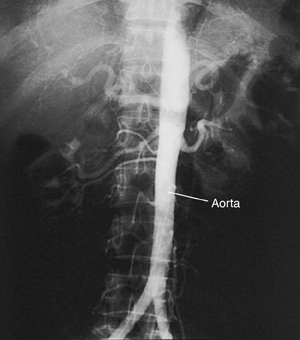Aortic Angiogram
An aortic angiogram is a test that takes pictures of the aorta. This is the main blood vessel that carries blood from your heart to the rest of your body. The test can show problems with your aorta. These include a blockage or an aneurysm (a balloon-like bulge in the wall of the aorta).

Before the test
Get ready for the test as you’ve been told. Also:
The day of the test
This test takes about 1 to 2 hours. The whole test (including time to get ready and recover) takes about 4 to 6 hours. You’ll likely go home the same day.
Before the test starts
-
An IV line is put into a vein in your arm or hand. This line gives fluids and medicine.
-
You’ll be given medicine (anesthesia) to keep you free of pain during the test. You may get sedation. This makes you relaxed and sleepy. Local anesthesia is also injected into the skin to numb the area to be worked on (groin or arm).
During the test
-
A small puncture or cut is made in the numbed skin.
-
A thin tube called a catheter is put through the puncture or cut and into a blood vessel.
-
The catheter is slowly advanced through the blood vessel and into the aorta. Live X-rays (fluoroscopy) are used to help guide this process. The X-rays are viewed on a video screen.
-
Once the catheter is in the right place, contrast fluid (dye) is sent through the catheter. X-ray pictures are then taken of the aorta. The contrast fluid (dye) makes the aorta easier to see on the pictures.
-
When the test is done, the catheter is taken out. Pressure is put on the insertion site to stop any bleeding. The site is then bandaged.
After the test
-
You’ll need to lie still for 4 to 6 hours. This lessens the chance of bleeding at the insertion site.
-
When it’s time for you to leave the hospital, have an adult family member or friend ready to drive you home.
Recovering at home
Once at home, follow any instructions you’re given. Be sure to:
-
Drink lots of water to help flush any remaining contrast fluid out of your body. This may take up to 24 hours.
-
Take all medicines as directed. Some medicines should not be resumed after the angiogram to prevent an interaction with the contrast dye or damage to your kidneys. Be sure to ask your healthcare team about any potential reactions.
-
Care for the catheter insertion site as told. You may take off the bandage after 24 hours.
-
Check for signs of infection at the catheter insertion site (see below).
-
Do not bathe or shower until your bandage is taken off. If you wish, you may wash with a sponge or washcloth.
-
Don't do any heavy lifting or other strenuous activities as directed to prevent the site from opening and bleeding.
When to call 911
Call 911 if you have any of these:
-
Rapid, pounding, or irregular heartbeat
-
Signs of severe allergic reaction to the contrast fluid, such as trouble breathing
-
Feeling as if you're going to pass out
-
Sudden pain, swelling, coldness, or numbness in an arm or leg
When to call your healthcare provider
Call your healthcare provider if you have any of the following:
-
Fever of 100.4° F ( 38° C) or higher, or as directed
-
Signs of mild allergic reaction to the contrast fluid, such as rash, nausea, or vomiting
-
Signs of infection at the catheter insertion site, such as increased pain, redness, swelling, warmth, bleeding, or foul-smelling discharge
Follow-up care
The healthcare provider will likely talk with you about the initial results shortly after the test. A follow-up visit may also need to be scheduled.
Risks and possible complications
Risks and complications can include:
-
Bleeding
-
Infection
-
Blood clots
-
Damage to the aorta
-
Damage to the blood vessel used during the test
-
Abnormal heart rhythm
-
Problems due to the contrast fluid, such as allergic reaction or kidney damage
-
Risks of anesthesia or any other medicines used during the test (these risks will be discussed with you before the test)
Online Medical Reviewer:
Mary Mancini MD
Online Medical Reviewer:
Raymond Kent Turley BSN MSN RN
Online Medical Reviewer:
Ronald Karlin MD
Date Last Reviewed:
12/1/2021
© 2000-2024 The StayWell Company, LLC. All rights reserved. This information is not intended as a substitute for professional medical care. Always follow your healthcare professional's instructions.